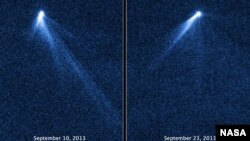Astronomers studying images from the Hubble Space Telescope have seen what they call a "weird and freakish" object in the asteroid belt between Mars and Jupiter.
Unlike other space rocks, which appear as tiny points of light, this asteroid has six comet-like tails of dust. The tails radiate from it like the spokes of a wheel, and dramatically change their structure every two weeks.
Lead investigator David Jewitt, from the University of California, Los Angeles, says he and his colleagues were dumbfounded when they first saw it. "It is hard to believe we're looking at an asteroid," he said.
When the asteroid, designated P/2013 P5, was discovered in August, through a land-based telescope array in Hawaii, it looked unusually fuzzy. The more detailed image taken by Hubble in September revealed the tails.
Jewitt's team suggests the asteroid is rotating so rapidly that its surface is flying apart, spewing dust in periodic eruptions. Radiation pressure from the Sun forces the dust out into streamers.
Jewitt says it may be the main way in which small asteroids die. He expects to find many more asteroids with tails.
News of the unusual asteroid appeared in The Astrophysical Journal Letters.
Unlike other space rocks, which appear as tiny points of light, this asteroid has six comet-like tails of dust. The tails radiate from it like the spokes of a wheel, and dramatically change their structure every two weeks.
Lead investigator David Jewitt, from the University of California, Los Angeles, says he and his colleagues were dumbfounded when they first saw it. "It is hard to believe we're looking at an asteroid," he said.
When the asteroid, designated P/2013 P5, was discovered in August, through a land-based telescope array in Hawaii, it looked unusually fuzzy. The more detailed image taken by Hubble in September revealed the tails.
Jewitt's team suggests the asteroid is rotating so rapidly that its surface is flying apart, spewing dust in periodic eruptions. Radiation pressure from the Sun forces the dust out into streamers.
Jewitt says it may be the main way in which small asteroids die. He expects to find many more asteroids with tails.
News of the unusual asteroid appeared in The Astrophysical Journal Letters.
